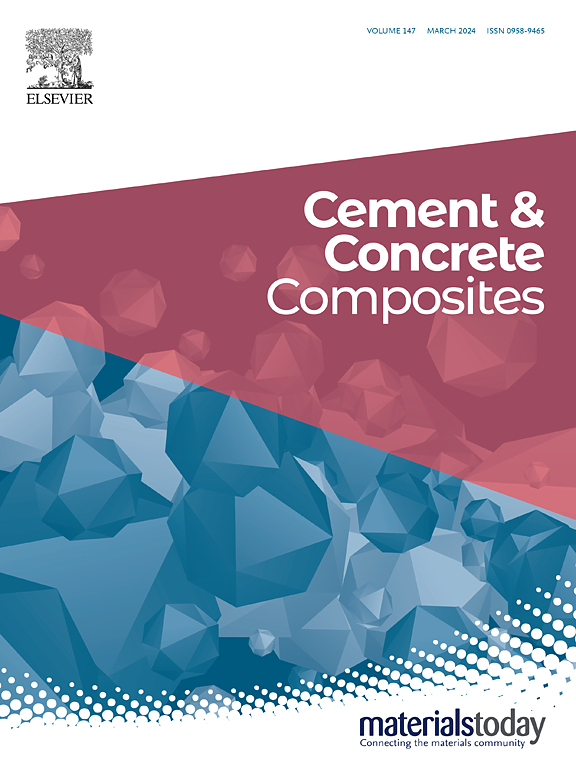asr损伤混凝土弹塑性性能及断裂机制试验研究
IF 10.8
1区 工程技术
Q1 CONSTRUCTION & BUILDING TECHNOLOGY
引用次数: 0
摘要
碱硅反应(ASR)损伤混凝土的裂缝模式受多种环境因素的影响而变化,具有分散裂缝模式的损伤混凝土表现出不同于由外部荷载引起的裂缝混凝土的压缩行为,而不是ASR损伤,尽管经历了大量的ASR膨胀。因此,研究控制asr损伤混凝土力学行为的机制是必要的。以ASR膨胀和长期储存条件为试验变量,对ASR损伤混凝土进行了单调和循环压缩试验。研究了asr损伤混凝土的弹塑性行为和断裂过程,并采用数字图像相关(DIC)测量方法观察了裂缝扩展。试验结果表明,随着ASR膨胀率的增大,混凝土的抗压强度、弹性模量和剪切弹性均有减小的趋势。然而,表征asr损伤混凝土断裂进程的断裂参数与未损伤混凝土相似。这表明,ASR损伤的混凝土裂缝分布分散,宽度小,尽管由于ASR产生了很大的拉伸应变,但通过裂缝之间的摩擦有效地传递了应力。此外,当试样在干燥而非潮湿条件下存放一年以上时,弹性模量、抗压强度和剪切弹性(ASR退化)均有所改善,而断裂参数基本保持不变。本文章由计算机程序翻译,如有差异,请以英文原文为准。
Experimental investigations on elasto-plastic behavior and fracture mechanism of ASR-damaged concrete
The crack patterns of alkali silica reaction (ASR)-damaged concrete vary depending on many environmental factors, and the damaged concrete with dispersed crack patterns shows a compressive behavior that differs from that of cracked concrete owing to external loads, not ASR damage, despite undergoing a substantial ASR expansion. Therefore, investigating the mechanisms governing the mechanical behavior of ASR-damaged concrete is necessary. Monotonic and cyclic compression tests were conducted on ASR-damaged concrete with ASR expansion and long-term storage conditions as test variables. The elastoplastic behavior and fracture progress of the ASR-damaged concrete were investigated, and crack propagation was observed using digital image correlation (DIC) measurements. The test results showed that the compressive strength, elastic modulus, and shear elasticity of the concrete tended to decrease with increasing ASR expansion. However, the fracture parameter representing the fracture progress of the ASR-damaged concrete resembled that of the undamaged concrete. This indicates that ASR-damaged concrete with dispersed crack patterns with small widths effectively transferred stress through friction between cracks despite undergoing a large tensile strain owing to ASR. In addition, when the specimen was stored under dry conditions rather than wet conditions for over one year, the elastic modulus, compressive strength, and shear elasticity—degraded by ASR— showed improvement, while the fracture parameter remained nearly unchanged.
求助全文
通过发布文献求助,成功后即可免费获取论文全文。
去求助
来源期刊

Cement & concrete composites
工程技术-材料科学:复合
CiteScore
18.70
自引率
11.40%
发文量
459
审稿时长
65 days
期刊介绍:
Cement & concrete composites focuses on advancements in cement-concrete composite technology and the production, use, and performance of cement-based construction materials. It covers a wide range of materials, including fiber-reinforced composites, polymer composites, ferrocement, and those incorporating special aggregates or waste materials. Major themes include microstructure, material properties, testing, durability, mechanics, modeling, design, fabrication, and practical applications. The journal welcomes papers on structural behavior, field studies, repair and maintenance, serviceability, and sustainability. It aims to enhance understanding, provide a platform for unconventional materials, promote low-cost energy-saving materials, and bridge the gap between materials science, engineering, and construction. Special issues on emerging topics are also published to encourage collaboration between materials scientists, engineers, designers, and fabricators.
 求助内容:
求助内容: 应助结果提醒方式:
应助结果提醒方式:


